
Centre takes steps to monitor pulse stocks: Is India staring at another food crisis?
The central government is taking steps to monitor the levels of pulse stocks across the country. Many are concerned that hailstorms and heavy rains during the second week of March and April may affect the harvest of pulses.
Secretary of the Central Consumer Affairs Department Rohit Kumar Singh attended the pulses trader’s meeting in Indore on April 15, 2023.
“Officials in the Union Ministry of Consumer Affairs, Food & Public Distribution visited 12 locations in various regions of the country to speak to traders. They advised traders to post data on pulses stocks to the ministry’s website every Friday and warned of a strict repercussion when the rules were not adhered to,” Rohit Singh told reporters.
The third estimate of the advance estimates for the major crops’ production in 2022-23, as compiled by the Union Ministry of Agriculture and Farmers Welfare, will be announced around the middle of May.
The second set of estimates for 2023 was released on February 14, 2023. The pulse production total during the 2022-23 market season was projected to grow by a significant amount over the previous year.
“Bengal gram crops were damaged in parts of the country due to the rains on March 15 and the first week of April,” AK Tiwari, former director of the Directorate of Pulses Development, Department of Agriculture and Farmers Welfare to the rains on March 15 and the first week of April, told Down To Earth.
There are instances of damages, particularly that of Rajasthan in particular and Madhya Pradesh, but this loss is just three to five percent. This should not affect all production levels of pulse, he said.
Tiwari said that 52 percent of pulses are grown in the country during the Rabi season and 48 percent in the Kharif season. “The two main pulse crops in the Rabi season include Bengal grams and pink lentils. Bengal grams account for 66 percent of the total output in the Rabi season,” he added.
Typically, 11 million acres of black gram are grown in the country during the Rabi season. However, seven percent more land was sown using black gram during the current Rabi season (2022-23), which means that the yield is predicted to rise by 18 percent.
Lentils in pink are planted within 1.4 million ha in most cases. However, the area of sowing has increased by 21 percent in this Rabi season (2022-23), which could result in a 19 percent growth in production, he added. “In this scenario, even if the yield is affected due to rain, the effect will be low,” Tiwari declared.
The area covered by pulses is 6 percent smaller than in the previous Kharif year (2022-23), which means that an increase of just three percent in the production is expected, according to him. The sown area for the current Rabi season stands at 11% higher than the previous year’s 17 million acres.
When asked what the reason was for taking pulses in stock if the yield wasn’t expected to drop, Tiwari said the government is extra vigilant when it comes to food security and nutrition.
Low pulse production
The pulses’ total production for 2021 – 22 totaled 27.3 million tonnes, whereas production was forecast to be 27.81 million tonnes under the most recent estimates. The production target for this year was set in the range of 29.55 million tonnes.
The government could be concerned over the decline in the manufacturing of arhar, also known as terror pigeon pea, according to an expert, even though estimates anticipated an increase in the number of pulses.
In the previous Kharif year, the goal of pigeonpea production within the region was 4.55 million tonnes. But the amount produced was just 3.66 million tonnes, despite the fact that the output stood at 4.22 million tonnes in the previous year.
A decrease in the area sown may be the cause for the lower production of the pigeon pea. The crop was planted on 4.2 million hectares across The country between 2022 and the previous year. It was sown on 4.75 million acres.
Pigeon peas are usually planted in June and July and mature after 6-8 months. The long time between sowing could be the cause for the decrease in the sowing area, stated Suresh Agarwal, who is president of the All India Dal Mill Association.
“Farmers plant Bengal gram (chana) and green gram (moong) over pigeon pea as these take less time to ripen,” he added. “Growers require a greater the minimum support price for pigeon peas in order to sow more. The government could also invest in developing pigeonpea varieties that require less time to sow,” he said.
The Indian Agricultural Research Institute is developing these types, Singh said to reporters.
The production of black gram or urad was predicted to fall. The agriculture ministry had previously set a target to produce 3.7 million tonnes of black gram in the coming year. The production was estimated at 2.68 million tonnes in comparison to 2.77 millimetric tonnes as per the second estimate for advance.
However, the production of other pulses such as Bengal grams, green gram, and pink lentils (masoor) was anticipated to rise.
The exact extent of the deficit in the production of pulses will be revealed following the publication of the third estimate of advance. However, the pulse traders are already taking advantage of the situation, which is why the Centre reviewing the current reality is a positive move.

